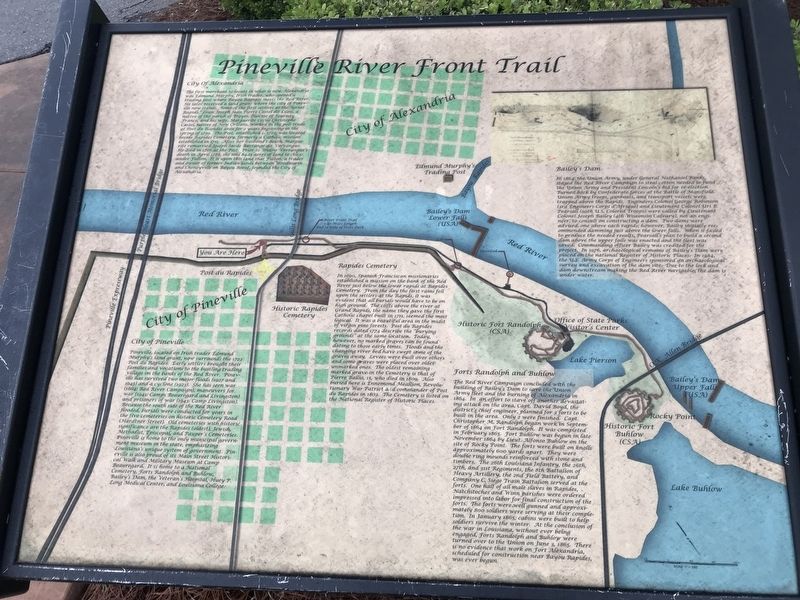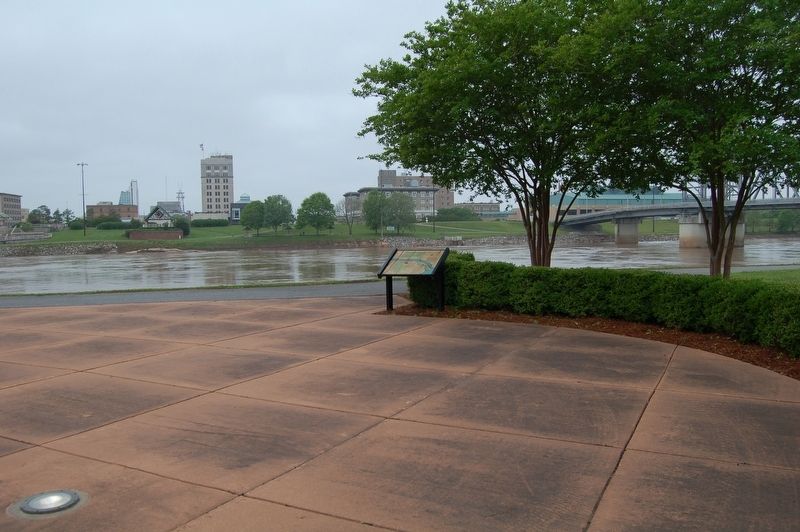Pineville River Front Trail
The first merchant to locate in what is now Alexandria was Edmund Murphy, Irish trader, who opened a trading post where Bayou Rapides meets the Red River. He later received a land grant where the city of Pineveille now stands. Some of the first settlers at the “Great Rapids," Louis Joseph Jean Pierre Castel dit Lilois, a native of the parish of Troyes, Diocese of Tournay France, and his wife, Marguerite Cecile Christophe Castel, native of New Orleans, worked in the pelt trade at Post du Rapides area for 2 years beginning in the spring of 1739. The Post, established c. 1722, was located beside Rapides Cemetery, formerly a Catholic mission established in 1711. After her husband's death, Marguerite remarried Joseph Sarde Barrange dit Varrangue. He died in 1766 at the Post. Prior to Widow Varrangue's death in April 1788, she sold 84.15 acres of land to Alexander Fulton. It is upon this land that Fulton, a trader and owner of former Indian lands between Woodworth and Cheneyville on Bayou Boeuf, founded the City of Alexandria.
Pineville, located on Irish trader Edmund Murphy's land grant, now surrounds the 1722 Post du Rapides. Early settlers brought their families and vocations to the bustling trading village on the banks of the Red River.
Pineville has survived two major floods (1927 and 1945) and a cyclone (1923). She has seen war (1864: Red River Campaign), maneuvers for war (1941: Camps Beauregard and Livingston) and prisoners of war (1943: Camp Livingston). Because the south side of the Red River flooded, burials were conducted for years in the five cemeteries on historic Cemetery Road (Hardtner Street). Old cemeteries with historic significance are the Rapides (oldest), Jewish, Methodist, Episcopal, and Pauper's Cemeteries. Pineville is home to the only municipal government museum in the state, emphasizing Louisiana's unique system of government. Pineville is also proud of its Main Street Historia - cal Walk and Military Museum at Camp Beauregard. It is home to a National Cemetery, Forts Randolph and Buhlow, Bailey's Dam, the Veteran's Hospital, Huey P. Long Medical Center, and Louisiana College.In 1690, Spanish Franciscan missionaries established a mission on the bank of the Red River just below the lower rapids at Rapides Cemetery. From the day the first rains fell upon the settlers at the Rapids, it was evident that all burials would have to be on high ground. The cliffs above the river at Grand Rapids, the name they gave the first Catholic chapel built in 1711, seemed the most logical. It was a beautiful area in the midst of virgin pine forests. Post du Rapides
records dated 1774 describe the “burying grounds” at the same location. Today, however, no marked graves can be found dating to those early times. Floods and the changing river bed have swept some of the graves away. Levees were built over others and some graves were placed over older unmarked ones. The oldest remaining marked grave in the Cemetery is that of Pierre Ballio, 15, who died in 1809. Also buried here is Ennemond Meallion, Revolutionary War Patriot and commander of Post du Rapides in 1803. The Cemetery is listed on the National Register of Historic Places.The Red River Campaign concluded with the building of Bailey's Dam to save the Union Army fleet and the burning of Alexandria in 1864. In an effort to stave off another devastating attack on the area, Capt. David Boyd, the district's chief engineer, planned for 3 forts to be built in the area. Only 2 were finished. Capt. Christopher M. Randolph began work in September of 1864 on Fort Randolph. It was completed in February 1865. Fort Buhlow was begun in late November 1864 by Lieut. Alfonso Buhlow on the site of Rocky Point. The forts were built on knolls approximately 600 yards apart. They were double ring mounds reinforced with stone and timbers. The 26th Louisiana Infantry, the 26th, 27th, and 31st Regiments, the 8th Battalion of Heavy Artillery, the
2nd Field Battery, and Company C, Siege Train Battalion served at the forts. One half of all male slaves in Rapides, Natchitoches and Winn parishes were ordered impressed into labor for final construction of the forts. The forts were well gunned and approximately 800 soldiers were serving at their completion. In January 1865, cabins were built to help soldiers survive the winter. At the conclusion of the war in Louisiana, without ever being engaged, Forts Randolph and Buhlow were turned over to the Union on June 3, 1865. There is no evidence that work on Fort Alexandria, scheduled for construction near Bayou Rapides, was ever begun. In 1864, the Union Army, under General Nathaniel Banks, staged the Red River Campaign to steal cotton needed to fund the Union Army and President Lincoln's bid for re-election. Turned back by Confederate forces at the Battle of Mansfield, Union Army troops, gunboats, and transport vessels were trapped above the Rapids. Engineers Colonel George Robinson (3rd Engineers Corps d Afrique) and Lieutenant Colonel Uri B. Pearsall (99th U.S. Colored Troops) were called by Lieutenant Colonel Joseph Bailey (4th Wisconsin Calvary), not an engineer, to consult on constructing a dam. Two dams were advised, one above each rapids; however, Bailey initially recommended damming just above the lower falls. When it failed to produce the needed results, Pearsall's plan to build a second dam above the upper falls was enacted and the fleet was saved; Commanding officer Bailey was credited for the project. In 1976, archaeological remains of Bailey's Dam were placed on the national Register of Historic Places. In 1984, the U.S. Army Corps of Engineers sponsored an archaeological survey and excavation of the dam site. Due to the lock and dam downstream making the Red River navigable, the dam is under water.
Topics and series. This historical marker is listed in these topic lists: Settlements & Settlers • War, US Civil. In addition, it is included in the Former U.S. Presidents: #16 Abraham Lincoln series list.
Location. 31° 18.858′ N, 92° 26.516′ W. Marker is in Pineville, Louisiana, in Rapides Parish. Marker is at the intersection of Main Street and Riverfront Street on Main Street. At the terminus of Main Street. Touch for map. Marker is in this post office area: Pineville LA 71360, United States of America. Touch for directions.
Other nearby markers. At least 8 other markers are within walking distance of this marker. Pineville #1 (within shouting distance of this marker); Pineville #2 (within shouting distance of this marker); Pineville #3 (about 500 feet away, measured in a direct line); Old Rapides Cemetery (about 500 feet away); 200 Block of Main Street (approx. 0.2 miles away); Red River (approx. 0.2 miles away); The Jewish Cemetery (approx. 0.2 miles away); Old Rapides Bank Building (approx. 0.2 miles away). Touch for a list and map of all markers in Pineville.
More about this marker. Located at the Pineville Riverfront.
Credits. This page was last revised on April 9, 2018. It was originally submitted on April 9, 2018, by Cajun Scrambler of Assumption, Louisiana. This page has been viewed 506 times since then and 61 times this year. Photos: 1, 2. submitted on April 9, 2018.

